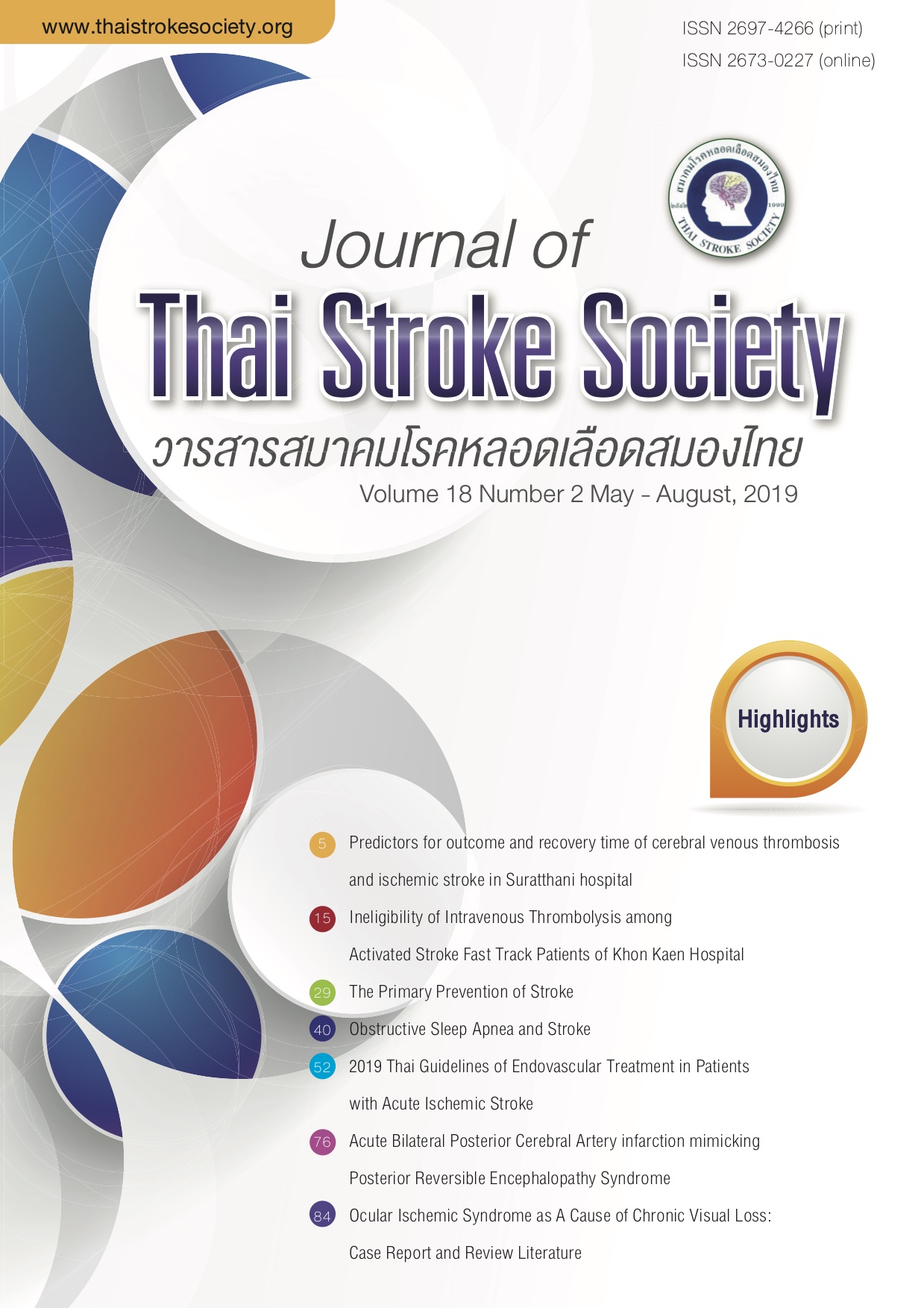Predictors for outcome and recovery time of cerebral venous thrombosis and ischemic stroke in Suratthani hospital
Keywords:
cerebral venous sinus thrombosis, prognosis, recovery timeAbstract
Background and objective: To study predicting factors for favorable clinical outcome and recovery time of cerebral venous sinus thrombosis (CVST) and acute ischemic stroke (AIS).
Materials and Methods: We performed a retrospective study in Suratthani Hospital, Thailand, between January 2013 and December 2018. All cases of CVST patients were included and compared with random samplings of AIS on the ratio of 1:1 in the same period. Disability at six months or until full recovery and time to recovery were assessed.
Results: 104 patients, there were 52 patients in each group. Mean age was 44 years in CVST patients and 70 years in AIS patients. In CVST group, age < 45 years (aOR = 5.69, 95% CI 1.51-21.39, P = 0.010) was associated to good recovery, whereas age < 65 years (aOR = 23.24, 95% CI 2.36-229.13, P = 0.007), and small vessel type arterial infarction (aOR = 17.49, 95% CI 2.91-105.10, P = 0.002) were predicting factors for good recovery in AIS. The median time to recovery was 60 days and 93 days in CVST and AIS, respectively.
Conclusion: Predictors for favorable outcome in cerebral venous thrombosis patients was age less than 45 years. Predictors for favorable outcome in ischemic stroke patients were age less than 65 years and small vessel subtype.
References
2. Luo Y, Tian X, Wang X. Diagnosis and Treatment of Cerebral Venous Thrombosis: A Review. Frontiers in aging neuroscience. 2018;10:2.
3. Lee DJ, Ahmadpour A, Binyamin T, Dahlin BC, Shahlaie K, Waldau B. Management and outcome of spontaneous cerebral venous sinus thrombosis in a 5-year consecutive single-institution cohort. Journal of neuro- interventional surgery. 2017;9(1):34-8.
4. Poungvarin N, Prayoonwiwat N, Ratanakorn D, Towanabut S, Tantirittisak T, Suwanwela N, et al. Thai venous stroke prognostic score: TV-SPSS. Journal of the Medical Association of Thailand. 2009;92(11):1413-22.
5. Hiltunen S, Putaala J, Haapaniemi E, Tatlisumak T. Long-term outcome after cerebral venous thrombosis: analysis of functional and vocational outcome, residual symptoms, and adverse events in 161 patients. Journal of neurology. 2016;263(3):477-84.
6. Kowoll CM, Kaminski J, Weiss V, Bosel J, Dietrich W, Juttler E, et al. Severe Cerebral Venous and Sinus Thrombosis: Clinical Course, Imaging Correlates, and Prognosis. Neurocritical care. 2016;25(3):392-9.
7. Ferro JM, Canhao P, Stam J, Bousser MG, Barinagarrementeria F, Investigators I. Prognosis of cerebral vein and dural sinus thrombosis: results of the International Study on Cerebral Vein and Dural Sinus Thrombosis (ISCVT). Stroke. 2004;35(3):664-70.
8. Ferro JM, Lopes MG, Rosas MJ, Fontes J, Investigators V. Delay in hospital admission of patients with cerebral vein and dural sinus thrombosis. Cerebrovascular diseases. 2005;19(3):152-6.
9. Canhao P, Ferro JM, Lindgren AG, Bousser MG, Stam J, Barinagarrementeria F, et al. Causes and predictors of death in cerebral venous thrombosis. Stroke. 2005;36(8):1720-5.
10. Karadas S, Milanlioglu A, Gonullu H, Sayin R, Aydin MN. Cerebral venous sinus thrombosis presentation in emergency department in Van, Turkey. JPMA The Journal of the Pakistan Medical Association. 2014;64(4):370-4.
11. Zuurbier SM, Middeldorp S, Stam J, Coutinho JM. Sex differences in cerebral venous thrombosis: A systematic analysis of a shift over time. International journal of stroke : official journal of the International Stroke Society. 2016;11(2):164-70.
12. Wasay M, Bakshi R, Bobustuc G, Kojan S, Sheikh Z, Dai A, et al. Cerebral venous thrombosis: analysis of a multicenter cohort from the United States. Journal of stroke and cerebrovascular diseases : the official journal of National Stroke Association. 2008;17(2): 49-54.
13. Sidhom Y, Mansour M, Messelmani M, Derbali H, Fekih-Mrissa N, Zaouali J, et al. Cerebral venous thrombosis: clinical features, risk factors, and long-term outcome in a Tunisian cohort. Journal of stroke and cerebrovascular diseases : the official journal of National Stroke Association. 2014;23(6): 1291-5.
14.Kalita J, Chandra S, Kumar B, Bansal V, Misra UK. Cerebral Venous Sinus Thrombosis From a Tertiary Care Teaching Hospital in India. The neurologist. 2016;21(3):35-8.
15. Breteau G, Mounier-Vehier F, Godefroy O, Gauvrit JY, Mackowiak-Cordoliani MA, Girot M, et al. Cerebral venous thrombosis 3-year clinical outcome in 55 consecutive patients. Journal of neurology. 2003;250(1): 29-35.
16. Anadure R, Wilson V, Sahu S, Singhal A, Kota S. A study of clinical, radiological and etiological profile of cerebral venous sinus thrombosis at a tertiary care center. Medical Journal Armed Forces India. 2018;74(4): 326-32.
17. Uzar E, Ekici F, Acar A, Yucel Y, Bakir S, Tekbas G, et al. Cerebral venous sinus thrombosis: an analyses of 47 patients. European review for medical and pharmacological sciences. 2012;16(11): 1499-505.
18. Davalos A, Castillo J, Martinez-Vila E. Delay in neurological attention and stroke outcome. Cerebrovascular Diseases Study Group of the Spanish Society of Neurology. Stroke. 1995;26(12):2233-7.
19. Santamarina E, Abraira L, Toledo M, González-Cuevas M, Quintana M, Maisterra O, et al. Prognosis of post-stroke status epilepticus: Effects of time difference between the two events. Seizure. 2018;60:172-7.
Downloads
Published
How to Cite
Issue
Section
License
ข้อความภายในบทความที่ตีพิมพ์ในวารสารสมาคมโรคหลอดเลือดสมองไทยเล่มนี้ ตลอดจนความรับผิดชอบด้านเนื้อหาและการตรวจร่างบทความเป็นของผู้นิพนธ์ ไม่เกี่ยวข้องกับกองบรรณาธิการแต่อย่างใด การนำเนื้อหา ข้อความหรือข้อคิดเห็นของบทความไปเผยแพร่ ต้องได้รับอนุญาตจากกองบรรณาธิการอย่างเป็นลายลักษณ์อักษร ผลงานที่ได้รับการตีพิมพ์ในวารสารเล่มนี้ถือเป็นลิขสิทธิ์ของวารสาร





